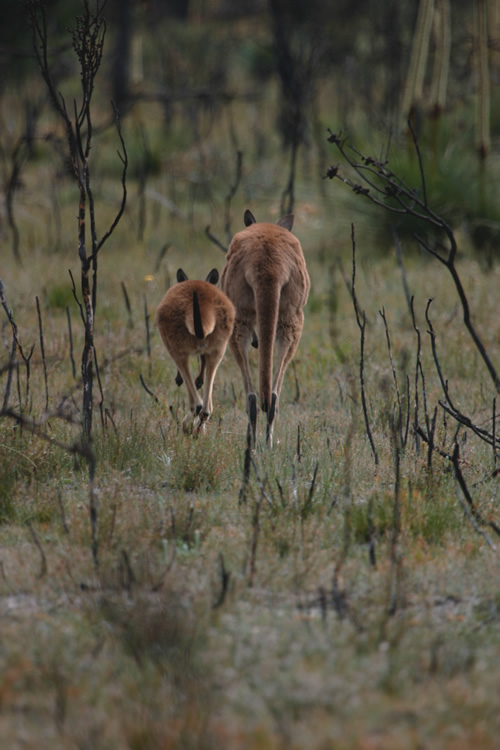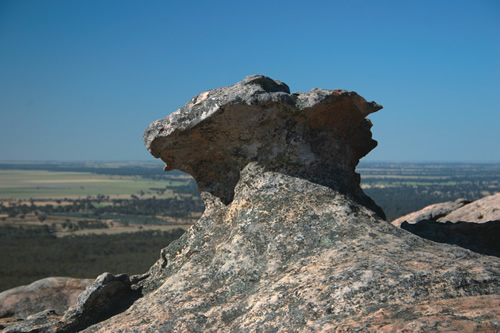Mammal Monitoring
Join Conservation Volunteers in Australia’s Grampians National park
Article and Photos by Inger Vandyke

|
|
The Grampians supports some 40 species of mammals, including kangaroos
|
I joined Conservation Volunteers, along with participants
from Australia and Japan, to monitor the movements of some of the mountains’ most
vulnerable native animals for four days. For many years, the Grampians of
my imagination was a place of endless allure. Rocky carapaces punctuated by
caves, cliffs, overhangs, and a myriad of hiking trails silently beckoned
exploration. When the opportunity came to discover this spectacular region
through volunteering, I jumped at the opportunity to give something back to
the mountain landscapes I have loved since I was young.

|
|
Wind-eroded stone characterizes the summit of Mount Hollow.
|
On our first morning, we woke at 6:30 a.m. “Surely that can’t be my alarm,” I thought, jolted by the digital bleep. I got up to throw on my old hiking boots, long pants, and a long sleeved shirt for my first morning of checking traps with the rangers and other volunteers. Shouts of “OB” or “open baited” echoed along each 100-meter long transect until a magical “CA” or “closed animal” was heard. We then engaged in “trap lottery,” as we tried to guess what we had caught. Peering under the cover, a tiny pair of eyes stared back. They belonged to a swamp rat, one of the smallest native animals regularly caught on the project. We bundled him into a bag where he was weighed, and a small amount of fur was clipped to avoid stress of recapture before he was left to run off into the wild once more.
Eventually, park rangers hope that a combination of mammal monitoring
and fox baiting will create a suitable landscape for the reintroduction
of captive bred brush-tailed rock wallabies into the wild. Listed
by the International Union for the Conservation of Nature and
Natural Resources as vulnerable, Brush-tailed Rock Wallabies
have been extinct in the park since 1999. Tying in with the
National Threatened Species Day, the first animals have been
released back into the park via a half-way habitat already established
on the outskirts of Dunkeld, a small village nestled in the
foothills of the Grampians. Participating on the project, it’s
difficult not to want to join the park staff in its commitment
to achieve this momentous outcome.
Each day we struggled to tear ourselves away from the fun of mammal tracking, only to be enticed into other activities that included visiting ancient aboriginal rock art sites, looking for wildflowers or hiking in areas of the park that were not affected by fire. On our trip, we chose to summit Mount Hollow, the lofty heights of which allowed us to fully grasp the beauty of the park in all its grandeur. Mount Hollow’s peak has been sculpted by wind into caves, grottoes, and sharp cliffs. Taipan Wall, a longstanding mecca for rock climbers from around the world, is clearly visible from the top.
Retiring to our accommodation at the superb Youth
Hostel Association Eco-hostel in the Grampians, we reflected on each day’s activities over home cooked meals. We bounced our recollections off each other and exchanged highlights of spotting rare endemic orchids, countless grass trees in bloom, momentous mountain scenery, detailed rock art, and the chance to get up close and personal with some of the cutest animals on the planet.
|
|
For More Info
Spring in Australia (October and November) offers the best conditions for joining the mammal tracking program in the Grampians. The mountains are alive with blooming wildflowers and temperatures are generally pleasant. Halls Gap also offers a variety of guesthouses and bed and breakfasts to suit all budgets. The first stop on the web for accommodation in this pretty village can be found at Halls Gap.
If you are interested in other volunteer trips in Australia, such as helping with projects at a world heritage area in Tasmania or monitoring sea birds on Montague Island, visit the Conservation Volunteers.
|
Inger Vandyke is a freelance photojournalist based in Newcastle, Australia. She specializes in ecotourism projects that are heavily volunteer based. Her work has taken her to Australia and New Zealand working on projects that involve conservation of penguins and albatross, island conservation, marine park awareness, koala habitat rehabilitation, rescuing sea turtles, invasive plant removal, and endangered plant protection.
|
